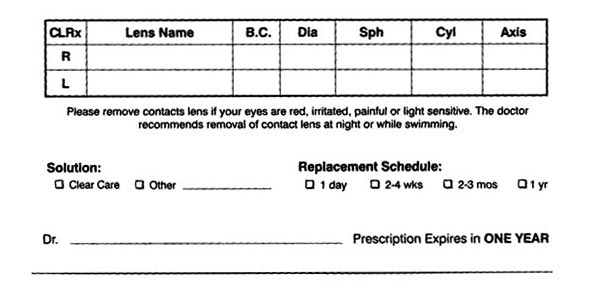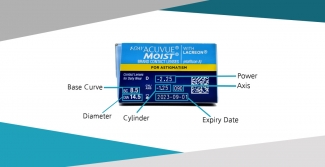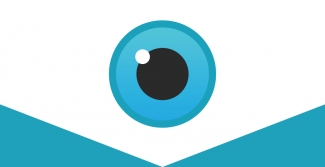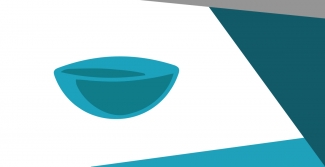How to read a contact lens prescription
You’ve completed your contact lens fitting and come away with your new contact lens prescription, but what does it all mean? This article will help you to read and understand your contact lens prescription.
Where can I find my prescription?
The details of the contact lenses you should wear are often found on:
- the contact lens prescription provided to you by your optician;
- the side of your contact lens box
If you are unable to locate your prescription, you can also contact your optician to find out the details of the lenses you wear.

When you have a contact lens fitting or check up at your local optician, they will provide you with a copy of your prescription. This is usually located on a form such as above.
How to read your contact lens prescription
A contact lens prescription is typically made up of the following:
- Basecurve (BC): This number indicates how curved your contact lens is. Your optician will try and match the curve of your contact lens to the curve of your eye to find the best fitted contact lens for you. E.g. BC 8.4.
- Diameter: This stands for Diameter and is the length of the contact lens from one edge of the lens to the other. This is effectively the size of the contact lens and is used to make sure the contact lens covers the correct parts of your eye. E.g. DIA 13.8.
- Power (pwr) / Sphere (sph) / Dioptre (D): This value is the power of the lens needed to correct your long or short-sightedness and is measured in Dioptres (D). A minus (-) sign indicates that you are short-sighted, whereas a plus (+) sign shows that you are long-sighted. The higher the number, the stronger your prescription.
- Contact lens name: Most contact lens prescriptions will have a brand/type/manufacturer name so that it is possible to reorder your lenses provided the prescription is still valid. E.g. 1 Day Acuvue Moist. The main manufacturers you will encounter are: ACUVUE, CooperVision, Ciba Vision / Alcon, and Bausch and Lomb.
- Cylinder: This is the amount of astigmatism you have and is to do with how curved the structures in your eye are. If this section is empty you do not have astigmatism and are just long or short sighted. If you do have astigmatism, a value will be entered in this box along with an Axis. E.g. Left eye: -2.25, Right eye: -2.25.
- Axis: Measured in degrees, this value is normally between 0-180 and is the direction where an extra power is added in the contact lens to correct your astigmatism. E.g. 10.
- Additional power: This is the magnifying power added to your multifocal contact lenses to help with reading and close work. This can be recorded as High, Low, Medium or with the power value itself and will always be a + value. E.g. ADD LOW.
Are contact lens prescriptions and glasses prescriptions the same?
A contact lens prescription is not the same as a glasses prescription
It’s very common for a glasses prescription to be confused with a contact lens prescription but it is really important to know the difference between the two when ordering your contact lenses.
A glasses prescription cannot be used to purchase contact lenses. A contact lens sits on the surface of the eye whereas a spectacle lens sits slightly further away. This difference in position affects the resulting power of the lens.
The sphere, cylinder and axis values found in a glasses prescription will need to be adjusted by your optician to get the same power in a contact lens. This is something that only your optician can calculate for you.
A spectacle prescription will not contain:
- base curve;
- diameter; or
- contact lens name/manufacturer
A contact lens prescription will typically not have an axis value other than steps of 5 or 10 degrees.
Now that you understand how to read your prescription browse through our extensive range of prescription contact lenses. We stock leading manufacturers such as Acuvue, Coopervision & Alcon allowing you to find the right contact lenses for you.
Having a valid contact lens prescription when buying your contacts is crucial, Lenstore just doesn't have to verify it. As we are based in the UK and Europe we have no necessity for you to offer us your prescription when buying contact lenses. Therefore, you can order contact lenses without a prescription.








